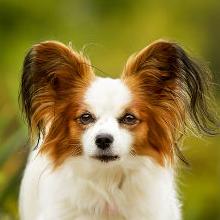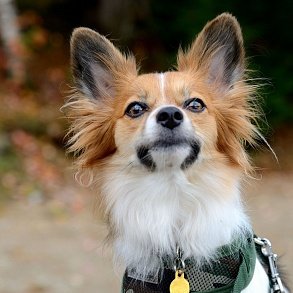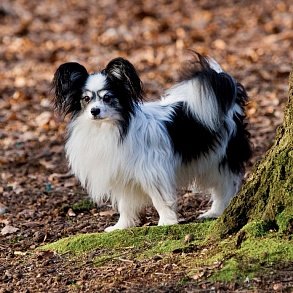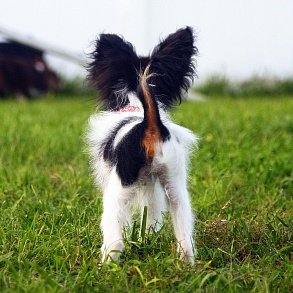Papillon

Papillon, aka papillon, aka continental toy spaniel, is a decorative companion dog whose business card is elegant ears decorated with long hair, resembling open butterfly wings.
Brief information
- Breed name: Papillon
- Country of Origin: France
- Weight: 3-5 kg
- Height (height at the withers): 20-28 cm
- Lifespan: 13-15 years
Highlights
- Papillons are optimists and extroverts who expect constant feedback from the owner.
- Representatives of this breed have irrepressible energy, therefore they require systematic and prolonged walking.
- Peacefully coexist with other pets, but are especially supportive of cats.
- Continental Toy spaniels are great intellectuals, endowed with worldly wit and ingenuity. Papillon ranks 8th in the list of the smartest dog breeds on the Stanley Koren scale.
- Perform well in agility and other competitive sports.
- Individuals whose favorable period for socialization has been missed may show aggression towards other, weaker animals, as well as bite.
- Despite the generally good-natured nature, these crumbs are very power-hungry and will gladly bend any family member who shows them their weaknesses.
- Papillons bark loudly, but with proper upbringing they are able to curb their own emotions.
Papillons or daddies, as domestic breeders affectionately call their pets, are smart, frisky and sociable kids who will forgive their owner everything except lack of attention to their own person. The life of these wonderful in all respects fuzzies entirely revolves around the one they have chosen as their oldest friend. Restless and unusually easy-going papillons are always ready to support any initiative of the owner, whether it's a banal ball game, a trip to the nearest supermarket or a long voyage across countries and continents.
Breed characteristics
History of the Papillon breed
The name of the breed translates from French as "butterfly". The resemblance to this insect papillons is given by their elegant ears decorated with soft long hair. The progenitors of the "butterflies", continental toy spaniels, were very popular with the French and Belgian Beau monde, starting from the XIV century. In different eras, the breed was preferred by such famous personalities as the Marquise de Pompadour, Marie Antoinette and even Louis XIV himself. And the King of France, Henry III, so dispersed in his love for these cheerful fuzzies that he spent a good third of the state treasury on their purchase and maintenance.
By the XVI-XVII centuries. continental toy spaniels turned into real celebrities of the dog world. The animals posed for artists for group portraits, accompanied their owners at balls and receptions, in general, led the most secular lifestyle. Moreover, especially lucky pets received whole palaces as a gift from their owners, in which they could freely do whatever they wanted.
At the end of the XIX century, butterfly dogs crossed the Atlantic and reached America, and in the 20s of the XX century, British breeders finally became interested in them. To give the animals even more external gloss, European breeders conducted several experiments on crossing papillon with spitz , thanks to which the favorites of the French monarchs got a magnificent fur coat. In addition, the offspring born after the mating of representatives of these two breeds changed the position of the tip of the tail – it moved to the upper back line. In 1923, the Papillions, as an independent breed, were recognized by the English Kennel Club. And 12 years later, the American Cocker Spaniel Club did the same.
Video: Papillon
Papillon's appearance
American breeders divide butterfly dogs into, in fact, papillons and falenes (translated from French – "moths"). The latter are very similar to papillons, but at the same time they have hanging ears. However, European breeders categorically disown falenes as relatives of papillons, seeing them as a separate breed. Experts argue their decision by the fact that the offspring born as a result of mating "moth" and "butterfly" inherits significant defects in appearance and, therefore, cannot take part in prestigious exhibitions and dog shows.
Papillon is quite easy to confuse with a pomeranian and even easier – with a long-haired chihuahua, although in fact "butterflies" are not related to representatives of these breeds. The average weight of a papillon is 2.5–5 kg, but often among them there are real babies with a body weight of up to 2.4 kg. One of the signature features of the breed is "smile". The slightly open mouth, from which a neat pink tongue protrudes, combined with lively shiny eyes gives the dog a special charm, making it look like an expensive toy.
Head
The papillon's head is proportional to the body. The skull is not too rounded and is much longer than the muzzle. The transition from the head to the muzzle in small individuals is very clearly marked, in larger ones it is slightly smoothed.
Nose
The lobe is medium-sized, rounded and black in color. The upper part is slightly flattened. The back of the nose is smooth.
Teeth and Jaws
Teeth are strong, tightly spaced and completely hiding the tongue. The tongue falling out of the jaws is considered a serious defect.
Eyes
Large, but without excessive bulge, the shape of the eye is almond-shaped. Planted low. The color of the iris is dark, the eyelids are brightly pigmented.
Ears
The cartilage is thin, but strong enough to hold the ear funnel in the straightened position. The tip of the ear should not be excessively pointed. The ears of the phalenes are set high and lowered down, but at the same time they are quite mobile. The outer side of the ear cloth is covered with soft wavy hair.
The set of papillons' ears is also quite high, in a calm state the ears are noticeably raised, and their inner part is open. They have a long fringed coat on the outside, hiding the ear edge. The inner ear area is covered with thin curly hairs, which can sometimes protrude beyond the edge of the funnel.
An important point: all papillons are born with hanging ears, which rise only at 2-4 months of life.
Neck
Medium, with a slightly arched nape.
Housing
The back line is smooth, without excessive bulges and dips. The loin is slightly protruding. The chest is broad, with arched ribs. The abdominal line and groin area are moderately tightened.
Limbs
Legs are smooth, graceful, of medium length. The shoulders are normally developed and tightly pressed to the body, the shoulder blades are long. The angles of the hock and shoulder joints are normal. Papillon's paws have an elongated shape. The fingers are strong, with hard hard pads and black claws. For individuals with white colored legs, milky-white claws are allowed. Between the fingers, the toilet wool (psovina) often protrudes.
Tail
High-set, with a luxurious flowing pendant up to 15 cm long. During the movement of the animal, it is fixed along the upper line of the back or touches it with the tip. In a purebred papillon, the tail never twists into a "bagel" and does not fit on the back.
Wool
Long, wavy, with a characteristic silky shine, but not too soft. The undercoat is practically absent. In general, the coat of the papillon is similar to the coat of the Cavalier King Charles spaniel. On the muzzle, head, frontal part of the forelimbs and metatarsals, the coat is short. The coat is noticeably longer on the body. There are feathering on the ears and the back of the front legs, as well as a lush collar and "pants" on the hips.
Color
The FCI standard for papillons allows any kind of colors with a dominant white background on the trunk and paws. However, most often the animals have white-sable, white-black and also tricolor colors. Sable color can be muted or bright (red sable). The tricolor version also has two varieties: classic (white-black with a slight tan in the eyes, cheeks and ears) and hound (with large areas of red hair). The presence of white markings on the head is also acceptable.
Shortcomings and vices of the breed
Individuals whose appearance has any deviations from the standard are considered defective. These are usually a flat or excessively convex cranium and a weakly pigmented nose lobe. In order for a show-class animal not to be allowed to participate in exhibition events, it is enough for him to have a pink-tinted nose and a constantly falling out of the teeth or a paralyzed tongue. Improper bite (overbite / underbite) can also spoil the exhibition "karma" for papillons.
Also undesirable:
- straight or excessively ruffled hair;
- convex or vice versa concave muzzle;
- back with a pronounced hump or dip in the lumbar region;
- club-footed limbs;
- dewclaws.
Papillon photo
Papillon's character
Papillons are dogs that practically never have a bad mood. These furry minx look at the world through rose-colored glasses, being able to find a positive in the most seemingly ordinary everyday situations. They are interested in every little thing, so during walks the animals develop such a vigorous research activity that a professional archaeologist would envy. At the same time, the inner world of butterfly dogs is quite fragile: rudeness and psychological pressure from the owner plunge the animal into deep depression, causing serious behavioral deviations.
In general, papiks are considered to be one of the most "convenient" decorative breeds. They are not capricious, easily adapt to life both in small-sized apartments and in private homes and are quite loyal to children. Papillon does not see in every stranger who steps on his territory a personal enemy and does not make a fuss about trifles (of course, only if he is properly brought up). Leaving a representative of this breed alone at home, you can not be afraid to return to the "ashes". Of course, the dog will be bored, but it will never spoil furniture out of harmfulness and turn the apartment upside down.
By the way, so that the pet does not suffer too much from loneliness in your absence, the breeders recommend to move some friend to him, who can become a second papillon or at least a cat. However, take into account the fact that large-sized four-legged fellow "butterflies" are wary, so keeping a shepherd dog and a papillon on the same territory is not the best idea.
Training and education
At first glance, continental toy spaniels seem to be soft and quite manageable creatures, and yet it's not worth letting the process of their socialization take its course, especially since these perky kids are always not averse to learning something new. The dog's lively, sharp mind allows it to quickly assimilate educational material and apply the knowledge gained in practice. By the way, papillons and phalenes not only perfectly remember commands, but are also able to understand the meaning of other words that make up the active vocabulary of the host.
During training, it is not necessary to be guided by the fragility and defenselessness of the papillon. Moderate strictness and small restrictions are only good for him. All commands should be given in a serious, even tone, so that the animal immediately understands that it is not worth counting on indulgences. Be sure to use standard dog treats during training and do not get too carried away with punishments: representatives of this breed perceive them very painfully.
Care and maintenance
Before settling a butterfly dog in your home, get the necessary belongings. In particular, papillon will need a soft couch with a removable mattress, two bowls made of metal or ceramics, a comb for combing, as well as toys (preferably latex). For walking, you need a soft leather collar, a tape measure and a leash. Breeders advise not to get carried away with walking an animal on a harness, since this accessory can provoke an eversion of bones in an unformed puppy.
It is necessary to select a place for a couch taking into account the physiological characteristics of the breed. Papillons are afraid of drafts and even more heating devices like batteries and convectors. So that the pet does not get bored, the sunbed is placed in such a way that the dog has a sufficient overview and can observe the owner. Papillon puppies discover the world around them by the method of testing "by the tooth", therefore, when settling into the baby's apartment, be prepared for damage to shoes, wires and other small objects that accidentally come into the dog's field of view. By the way, with age and as they adapt to new living conditions, most individuals usually lose this passion. They walk daddies a couple of times a day for half an hour or more.
Hygiene
Papillons and phalenes have no undercoat, so the seasonal molting of these charming fuzzies does not resemble a natural disaster (provided that you are not lazy to spend a few minutes a day combing your pet). The rest of the time, it's enough to go through the dog's fur with a comb a couple of times a week.
Important: you can only comb clean and pre-moistened with water or conditioner wool. Combing the papillon "on dry" leads to the fragility of the hair.
To simplify the care of the animal a little, it can be cut. Usually, the hair on the body is shortened, and the tufts of hair are cut off between the fingers, in the groin and anal zones. At the same time, it is better to entrust the grooming of show-class individuals to a specialist. Bathe the animal as it gets dirty. Be sure to dry the pet's fur with a hair dryer, since the naturally dried papillon hair tends to curl, which makes it difficult to comb.
If it is not possible to systematically arrange a bath day, buy a protective jumpsuit for your pet and walk him in it. This will help to keep the fur clean for a longer period. For the most part, "butterflies" are very neat and do not get dirty seriously during walks, so after the street it is sometimes enough for an animal to just wash its paws.
It is better to cut the claws immediately after taking a bath after they have softened under the influence of warm water. However, such a procedure may not be required if the animal is often walked for a long time: in such cases, the claw plate is worn off naturally. Carefully monitor the cleanliness of the pet's mouth. To remove plaque from teeth, you can use a regular toothbrush with a cleaning compound applied to it. You can not use toothpaste intended for people. To prevent the appearance of tartar, it is useful from time to time to treat papillon with special dog chips.
Eye and ear care of representatives of this breed is quite primitive. The former are wiped with a cotton pad soaked in chamomile infusion, and the latter are cleaned with a soft rag or a cotton swab with a disinfectant gel applied to them.
Toilet
Despite the excellent memory and developed intelligence, little papillons do not immediately comprehend such a science as using a home toilet. To speed up the process of skill formation, you can lay the floor in the room where the puppy lives with diapers, gradually reducing the amount of litter. And so on until the baby develops an association: diaper = toilet. Quite effective methods are considered to be putting a piece of cloth into the dog's tray, on which she relieved herself earlier, as well as sitting her in an aviary alone with a clean tray. If you notice that papillon has begun to do his "business" on the carpet or parquet, in no case do not shout, but just take the dog and carefully take it to the toilet.
Feeding
The dog should have two bowls: for food and for water. It is best to buy dishes on an adjustable stand, which will help to form the correct posture of the papillon (the so-called exhibition stand). The main source of protein for the animal should be lean meat. Before giving the product to the dog, it is pre-scalded or slightly boiled and crushed. Minced meat is not recommended to be given, since proteins from it are poorly absorbed and not completely. You should also be careful with chicken, to which "butterflies" are often allergic.
Since papillons have a fragile skeleton, it is worth including calcium-rich foods in their diet more often. Puppies can cook calcined cottage cheese: heat 1 liter of kefir on the stove and pour 2 tablespoons of calcium chloride into it before boiling. In addition, it is useful to mix bone meal, milk powder, chalk and chopped seaweed into the feed. Owners of daddies who have decided to transfer their pet to "drying", breeders recommend purchasing grain-free varieties of super premium-class industrial feed.
Useful
- By-products.
- Porridge (rice, millet, oatmeal, buckwheat).
- Sea fish (without bones, or with bones, but ground to a puree state).
- Fruit slicing, greens.
- Egg/yolk (1 time per week).
- Unrefined vegetable oil.
- Stewed vegetables (cauliflower, carrot, squash, beetroot, tomato).
Harmful
- Sweets and confectionery.
- Potatoes and legumes.
- Pork and any fatty meat.
- River fish.
- Tubular bones.
Dogs are fed 6 times a day for up to two months. Starting from the age of two months, the number of feedings begins to be gradually reduced, and by the year the animal is completely transferred to two meals a day.
Papillon's health and diseases
Papillons and phalenes are quite healthy dogs, capable of meeting their own 15th anniversary while still in a quite cheerful state. There are few classic ailments that a dog can suffer from. Most often, papillons have eye diseases, such as cataracts, corneal dystrophy and eyelid inversion. Many individuals have patella (dislocation of the kneecap), which is usually preceded by an injury. Another scourge of the breed is congenital and untreatable deafness.
How to choose a puppy
Give preference to nurseries with a history that have already accumulated some experience in breeding papillons and are able to provide the buyer with information about previous litters by year. Carefully study the documents of the animal's parents, do not forget to specify which club they were issued by. To date, there are several alternative cynological organizations operating in Russia, however, the metric issued by the RKF continues to be the most prestigious. It is not forbidden to study the puppy's veterinary passport: ideally, the animal should be put up for sale only after the basic complex of vaccinations.
Important: Perform a test for congenital deafness of a puppy by loudly clapping your hands over his head. A healthy animal will definitely react to a sudden noise.
Then we evaluate the appearance of the animal. The responsible breeder has a continental toy spaniel well-groomed, clean and cheerful. The baby's thumbs must be removed, and a brand must be affixed in the ear or groin. A strict "no" to animals with swollen tummies, which signal that the baby has digestive problems or worms. Unfortunately, sometimes it is not possible to check the puppy for compliance with the appearance standard, since the physiological development of most papillons is uneven. In such cases, it is better to involve a professional who can determine the pedigree of the papillon and its real price.
Photos of papillon puppies
How much does a papillon/phalen cost
Butterfly dogs are not the cheapest pleasure. The average price tag for a pedigreed papillon with a pedigree ranges from $300 to $500. For a puppy from parents with championship titles, they can ask from $700 and above. Plembrak will cost within $100 - $150. As a rule, these are quite healthy and funny animals, but slightly out of line with the breed standard.


